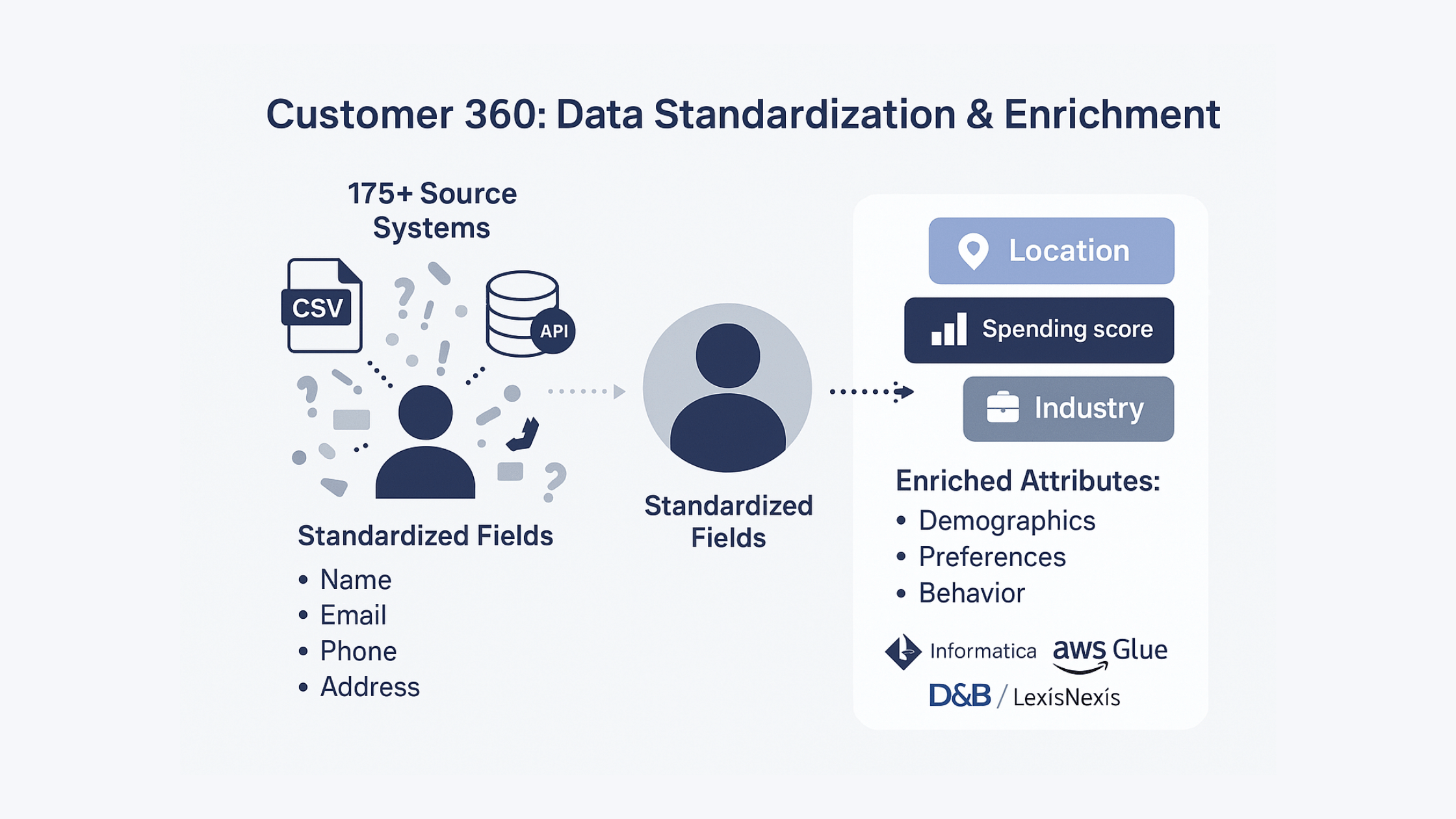
In our previous blog post Data Ingestion from Various Source Systems and Its Scale, we discussed the data ingestion process from various source systems into a common data repository. This foundational step was crucial for creating a unified view of customer data. In this post, we will delve into the next phase of the Customer 360 solution: data standardization and enrichment. These processes are essential for ensuring data consistency, accuracy, and completeness, ultimately leading to more informed decision-making and enhanced customer experiences.
Challenges Faced
- Inconsistent Data Formats: Data from different sources often comes in various formats, making it difficult to integrate and analyze.
- Missing or Incomplete Data: Some data sources may have missing or incomplete information, which can affect the quality of insights derived from the data.
- Duplicate Records: Multiple systems may contain duplicate records, leading to redundancy and potential inaccuracies.
- Data Quality Issues: Variations in data quality across sources can result in unreliable information.
- Integration of External Data: Enriching internal data with external sources can be challenging due to differences in data structures and formats.
Solution Provided by Yotta Tech Ports Inc.
Data Standardization: The process of data standardization involves transforming data into a consistent format, making it easier to integrate and analyze. Yotta Tech Ports Inc. implemented several techniques to achieve this:
- Data Cleansing: Identifying and correcting errors or inconsistencies in the data. This includes removing duplicates, correcting inaccuracies, and filling in missing values.
- Data Normalization: Converting data into a standard format. For example, standardizing date formats, address formats, and naming conventions.
- Data Transformation: Converting data from various formats into a common format that can be easily integrated. This includes converting data types, merging fields, and reformatting data.

Data Enrichment: Data enrichment involves enhancing the existing data with additional information from external sources. This process provides a more comprehensive view of the customer and improves the quality of insights. Yotta Tech Ports Inc. employed several methods for data enrichment:
- Integrating External Data Sources: Incorporating data from third-party sources, such as demographic data, social media data, and market data, to enrich the existing customer data.
- Appending Missing Information: Using external data to fill in missing information, such as contact details, demographic attributes, and behavioral data.
- Enhancing Data Attributes: Adding new attributes to the existing data, such as customer preferences, purchase history, and engagement metrics.
Technical Solution: Yotta Tech Ports Inc. utilized various tools and technologies to standardize and enrich the data, aligning to the customer tech stack.
- Informatica Data Quality: Used for data cleansing, normalization, and transformation. This tool provides robust data quality management capabilities.
- Integrate Third-party Data: We enriched the client’s customer data with third party data providers data, by applying the best-in-class data security practices. Some of the data providers we integrated with include Dun & Brad Street, StrikeIron (part of Informatica), Lexis Nexis, BlackBaud Target Analytics, MCH Strategic Data, NCOA database, and various publicly available School and University systems data.
Some of the key data normalization and cleansing performed at this stage of the Customer 360 solution include:
- Standardizing customer names to common camel casing, lookups against aliases
- Standardizing and validating Addresses against USPS database. Classifying deliverable v/s undeliverable addresses
- Standardizing Phone numbers into common format. Verifying area codes.
- Standardizing Email addresses into common format. Verifying if it’s a deliverable email address
Some of the key data enrichments performed at this stage of the Customer 360 solution include:
- Getting latest address and phone numbers, as some of the B2C customer data had aged over time
- Getting marketing attributes for the B2C customers. Some of them include, Political affiliations, financial attributes, Household attributes, religious attributes, Ethnicity attributes, Neighborhood attributes, and supported Social causes.
Look out for a more detailed blog post about our expertise in data enrichment space!
Apart from the above technical solution, Yotta Tech Ports Inc. Team has experience with other possible technical solutions at this stage of creating a Customer 360 solution. Some of them include:
- AWS Glue: Used for data transformation and integration. AWS Glue simplifies the process of preparing and loading data for analysis.
- Custom Python Scripts: Used for specific data transformation and enrichment tasks. Python scripts offer flexibility and customization for complex data processing needs.
Benefits to the Client
- Improved Data Consistency: Standardized data ensures consistency across all systems, making it easier to analyze and interpret.
- Enhanced Data Accuracy: Data cleansing and enrichment improve the accuracy of the data, leading to more reliable insights.
- Comprehensive Customer View: Enriched data provides a more complete view of the customer, enabling better decision-making and
- Increased Operational Efficiency: Automated data standardization and enrichment processes reduce manual effort and improve operational efficiency.
Conclusion
Data standardization and enrichment are critical steps in the Customer 360 solution. By transforming and enhancing the data, Yotta Tech Ports Inc. ensured that the client had access to consistent, accurate, and comprehensive customer information. This enabled the client to make more informed decisions, improve customer experiences, and drive business growth. Stay tuned for our next blog post, where we will discuss data serving to various consumers and how it further enhances the Customer 360 solution.


